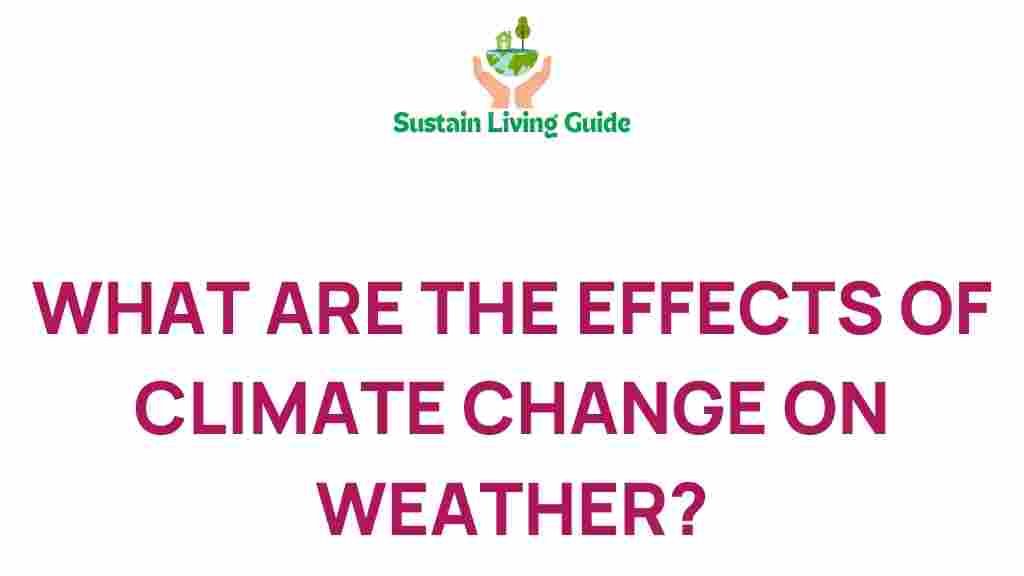Understanding the Impact of Climate Change on Weather Patterns
Climate change has emerged as one of the most pressing environmental issues of our time. It is not merely an abstract concept; it has tangible effects on our daily lives, particularly in how weather patterns manifest around the globe. As global temperatures rise, we are witnessing significant shifts in weather behaviors, leading to extreme weather events and altering the natural balance of ecosystems. In this article, we will delve into the effects of climate change on weather patterns, exploring the science behind it, the observable changes, and the implications for our future.
The Science Behind Climate Change
To fully understand the effects of climate change on weather, it’s essential to grasp the science that drives it. Climate change primarily stems from the increase in greenhouse gases (GHGs) in the atmosphere, such as carbon dioxide (CO2), methane (CH4), and nitrous oxide (N2O). These gases trap heat from the sun, leading to a gradual increase in the Earth’s average temperature.
- Greenhouse Effect: The greenhouse effect is a natural phenomenon where certain gases in the atmosphere trap heat, preventing it from escaping back into space. Human activities, particularly the burning of fossil fuels, have significantly increased the concentration of these gases.
- Global Warming: The term global warming refers to the long-term increase in Earth’s average surface temperature due to human-made emissions. This rise in temperature affects weather systems globally.
- Climate Models: Scientists use sophisticated climate models to predict changes in weather patterns. These models take into account various factors, including GHG emissions, solar radiation, and land use changes.
Observable Changes in Weather Patterns
The effects of climate change can be seen in various weather phenomena:
- Increased Temperature: Average temperatures have risen significantly, with many regions experiencing heatwaves more frequently. This can lead to droughts and increased evaporation rates.
- Extreme Weather Events: Climate change has been linked to an increase in the frequency and intensity of extreme weather events such as hurricanes, floods, and wildfires.
- Changes in Precipitation: Some areas are experiencing more intense rainfall, while others are facing prolonged droughts. This inconsistency can disrupt agricultural practices and water supply.
- Melting Ice Caps: The polar regions are warming at an alarming rate, leading to the melting of ice caps. This contributes to rising sea levels and impacts coastal weather patterns.
Step-by-Step Process: How Climate Change Affects Weather Patterns
Understanding the direct correlation between climate change and weather patterns involves a multi-step process:
- Emission of Greenhouse Gases: Human activities, such as industrial processes, deforestation, and transportation, release significant amounts of GHGs into the atmosphere.
- Heat Trapping: These gases trap heat, leading to an increase in the Earth’s temperature.
- Disruption of Climate Systems: The increase in temperature disrupts established climate patterns, causing shifts in atmospheric circulation.
- Altered Weather Events: As a result of disrupted climate systems, we experience changes in precipitation patterns, increased storm intensity, and altered seasonal conditions.
Impact on Ecosystems and Biodiversity
Climate change does not just affect weather; it also has severe implications for ecosystems and biodiversity. As temperatures rise and weather patterns change, many species struggle to adapt, leading to:
- Habitat Loss: Species that rely on specific habitats may find their environments rapidly changing, leading to population declines or extinctions.
- Ocean Acidification: Increased CO2 levels are absorbed by oceans, altering their chemistry and threatening marine life.
- Shifts in Species Distribution: Many species are migrating to cooler areas, disrupting existing ecosystems and food webs.
Troubleshooting Tips: Mitigating the Effects of Climate Change
While the effects of climate change on weather patterns are alarming, there are steps we can take to mitigate its impacts:
- Reduce Carbon Footprint: Individuals can lower their carbon emissions by using public transport, reducing energy consumption, and supporting renewable energy sources.
- Conserve Water: Implementing water-saving techniques can help manage the impact of changing precipitation patterns.
- Support Reforestation: Planting trees and supporting conservation efforts can help absorb CO2, thus reducing greenhouse gas levels in the atmosphere.
- Stay Informed: Educating oneself and others about climate change can foster a community that is proactive in addressing this global issue. For more information, check out this comprehensive guide on climate change.
Global Initiatives to Combat Climate Change
On a larger scale, several international efforts aim to combat climate change and its effects on weather patterns:
- The Paris Agreement: This landmark agreement aims to limit global warming to well below 2 degrees Celsius, with efforts to keep it below 1.5 degrees.
- United Nations Sustainable Development Goals (SDGs): These goals include targets related to climate action, emphasizing the need to combat climate change and its impacts.
- Local Government Initiatives: Many cities are adopting green policies, focusing on sustainability and resilience to climate impacts.
Conclusion: The Road Ahead
Climate change is a complex and multifaceted issue that profoundly affects weather patterns across the globe. As we continue to grapple with rising temperatures, extreme weather events, and ecological disruptions, it becomes increasingly crucial to acknowledge the urgency of the situation. By understanding the science behind climate change and its observable impacts, we can work together to implement effective strategies for mitigation and adaptation.
Everyone has a role to play in addressing climate change, from individuals to governments. By making informed decisions and advocating for sustainable practices, we can help ensure a healthier planet for future generations. Let us commit ourselves to understanding and combating climate change, not only for our sake but for all life on Earth.
This article is in the category Greenhouse and created by SustainLivingGuide Team
